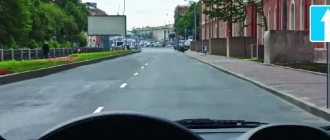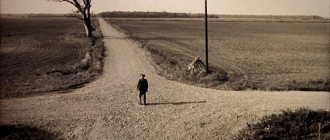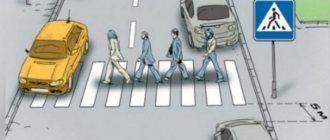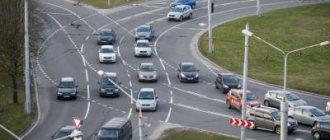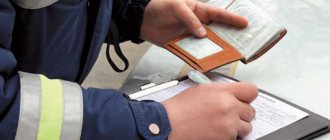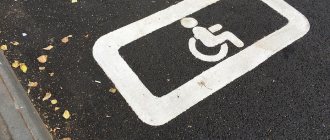Meaning of sign and variety
The sign has a digital designation of 5.5 in the traffic rules. This means the following - the road or roadway, which is located immediately behind this sign, has one-way (hereinafter also referred to as unidirectional) traffic. Simply put, there is no oncoming lane (it is located somewhere else).
Like almost all prescriptive signs, this one is designed as a square with a blue background, inside of which there is a white arrow pointing upward (see picture).
There are also subspecies 5.5:
- 5.7.1 – means that the road located to the right of the motorist has unidirectional traffic;
- 5.7.2 - means that on the road located to the left of the motorist, traffic is carried out exclusively in one direction.
These signs differ only in the direction of the white arrows. The shape of these signs is rectangular, the background is blue.
There is also an end of road sign (5.6), indicating the end of a section of road with traffic in one direction only. Immediately after this sign, two-way traffic begins - the left side of the road automatically becomes the oncoming side (unless otherwise regulated by sign 5.15.7 or road markings).
Expert opinion
Artemyev Dmitry
Experience as a forensic expert in the field of automotive technical examination for more than 2 years, more than 3 years of work in the field of insurance disputes, appealing guilt in road accidents.
Ask a Question
Did you know? Additionally, the start of two-way traffic may be indicated by warning sign 1.21.
5.6 looks like 5.5 - the only difference is that the first one has a diagonal red line (see photo).
There is also a 3.1 index (the so-called “Brick”). It is installed on the opposite side of a unidirectional road. Simply put, if the driver passes under the “brick”, then the traffic flow will meet him halfway. Route vehicles can enter under the “brick”, but an additional sign must be installed for them - 5.11.1.
Penalty for driving against one-way traffic – expert’s answer:
Who has the right to move on the oncoming road?
Government employees (ambulance, police, Ministry of Emergency Situations) have the right to drive in the opposite direction on a one-way road without a fine.
When seeing an ambulance, police or fire department vehicle with its emergency lights on, drivers are required to keep to the right side of the road to allow them to pass. Plus, public minibuses have the right to move in a separate lane. Private travelers are strictly prohibited from traveling there.
If there is an emergency situation in the car along with a serious malfunction and you need to move into the oncoming lane to avoid an emergency situation, it is recommended to press as close as possible to the edge so that other road users can pass. Otherwise, another emergency situation will be created, which will entail serious consequences.
As for turning around on a one-way lane, such an action is strictly prohibited. A U-turn is considered maneuvering, and an accident may occur in which other citizens will suffer.
In addition, when turning around on a one-way lane, the driver will move on the oncoming road. And the law provides for a fine for oncoming traffic on one-way traffic.
Arrangement rules
The placement of signs is carried out in accordance with GOST 52289-2004.
Some excerpts from there:
- 5.5 may not be installed to mark one-way roads leading to road service facilities (for example, gas stations), as well as on roads with separate routes;
- signs 5.7.1, 5.7.2 may not be installed near exits from courtyards and other adjacent territories, when entry there is possible only from roads indicated by sign 5.5;
- warning sign 1.21, signaling the start of two-way traffic, is installed outside cities at a distance of 150 - 300 meters, inside populated areas - 50 - 100 meters;
- 3.1 is installed immediately before the entry ban begins (including near gas stations, where 5.5 is not specifically installed);
- some signs can be re-installed - 5.5 or 5.11.1 - for example, after intersections with a complex layout.
How to recognize a one-way road
A motorist on a highway with a special travel regime is guided by signs indicating its boundaries. A sign notifying the beginning of a section of the road where traffic is allowed in one direction looks like this: on a blue background there is a bold white arrow pointing up. The installation location is the intersection of one-way roads.
Signs 5.7.1 or 5.7.2 (see Traffic Regulations) are placed at intersections; they indicate the direction on the route being crossed. A one-way road sign is depicted as a white horizontal arrow on a blue field, pointing left or right according to the direction of the road. The effect of this sign applies only to the intersection where it is installed. It does not prohibit movement directly.
The end of the route is indicated by a sign with a thick white arrow pointing upward on a blue background crossed out by a red line. On the exit side of such a road there is always a sign prohibiting traffic under it, which is popularly called a “brick”. It means that a vehicle passing under this sign is moving against the movement of cars.
Free legal consultation by phone:
Calls are free. We work seven days a week!
Riding Rules
Crossing a solid line and turning vehicles 180 degrees is a violation of one-way traffic rules. Having performed such actions, the car may end up in the oncoming lane. But in some situations, maneuvers on such routes are still permissible.
Reversing on a one-way road will not be considered an offense if the driver misses a turn and drives past his home or other property, but this does not apply to intersections. You can go back if the car is not an obstacle for other vehicles. It is recommended to turn on the hazard or sound signal to notify pedestrians or other drivers of your intention to make a maneuver.
If an accident on a one-way road could not be avoided, then the culprit of the offense will most likely be the driver of the car who was driving in the opposite direction and created the emergency situation. The penalty will depend on the details of the accident.
Travel options
When driving onto a one-way road, a citizen must consider the following:
- a one-way road can have several lanes (like a two-way road) - then you can take any convenient lane (if the one-way road is located in a populated area);
- when a one-way lane has three or more lanes, the leftmost lane can only be occupied during very heavy traffic, or when all other lanes are occupied, or for the purpose of changing lanes, or turning left, making a U-turn (in the latter case, if there is further two-way road);
- driving onto sidewalks and roadsides is prohibited;
- Before starting any maneuver, do not forget to signal with turn signals;
- a one-way road may have a dedicated bus lane (indicated by signs 5.11.1, 5.13.1, 5.13.2) - entering this “dedicated lane” is prohibited.
One-way traffic sign
According to paragraph 5 of Appendix 1 of the Traffic Regulations “Signs of special requirements”, this sign is intended to indicate one-way traffic.
Sign 5.5 “One-way road” is used to designate a road or carriageway along which the movement of vehicles across its entire width is carried out in one direction, and is installed at the beginning of the road or carriageway.
The sign may not be installed: - at the beginning of exits at intersections at different levels, driveways to service facilities where one-way traffic is carried out; - at the beginning of a one-way roadway, separated from a roadway with oncoming traffic by a dividing strip or boulevard, on roads with separate routing, in cases where visibility of the roadway with oncoming traffic is ensured from each of the roadways. Repeated sign 5.5 is installed after intersections with complex layouts.
GOST R 52289-2004
Signs 5.7.1 and 5.7.2 “Exit to a one-way road” are installed in front of all side exits to a section of road or carriageway marked with sign 5.5. Signs are placed above other signs installed with them on the same support. It is permissible not to install signs at exits from territories adjacent to the road if entry into these territories is possible only from the section of the road marked with sign 5.5.
GOST R 52289-2004
As we see, the designation of the last signs is identical, only the indication of the signs goes in opposite directions.
Departure methods
When the motorist saw sign 5.6, then after 150–300 meters outside the city (50–100 meters inside the settlement) the one-way road will end, so you need to prepare to leave it.
Important! 5.6 may not be installed if the total length of a one-way road is less than 100 meters, or if there is a T-shaped intersection at the end of its operation, or with a roundabout.
The departure rules are simple:
- when you need to continue driving in a forward direction, you should drive in the same lane as you were driving on a one-way road - the main thing is not to end up in oncoming traffic;
- if necessary, go to the right, you should give the appropriate turn signal, take the far right lane (paragraph 2 of clause 8.6 of the traffic rules), let pedestrians cross the roadway pass, and finally turn so that you are also in the far right lane;
- if you need to go left, you should take the far left lane (taking into account that the road will become two-way only after the intersection, either immediately after installing 5.6, or 150–300 (50–100 meters) after 1.21), turn on the left turn signal, let cars pass , moving straight or to the right, and, finally, turn so as not to end up in oncoming traffic (immediately after the left turn, you can enter any passing lane - not necessarily the far right one).
What is the fine for driving into the oncoming lane?
Depending on the circumstances and intentions of the driver, driving into oncoming traffic is punishable by a fine of 1 to 5 thousand rubles or deprivation of rights.
Alexander Torvard, car lawyer In my experience, the driver is most often given a fine for the first violation. Rights are deprived if the violation is repeated within a year. The inspector also takes into account the presence of unpaid fines and the violator’s “dossier” - if the driver often violated the speed limit or his behavior on the road was dangerous, most likely his license will be revoked.
Stopping and parking
Stopping and parking of vehicles on roads intended for one-way driving only is carried out in accordance with the general rules specified in Section 12 of the Traffic Rules:
- The vehicle must be parked on the side of the road, and when there is no shoulder, it is allowed to be parked along the edge of the roadway;
- stopping and parking for passenger cars less than 3500 kg are allowed both on the right and on the left (only in populated areas);
- trucks weighing more than 3500 kg may stop on the left solely for the purpose of loading and unloading;
- when there is less than 3 meters between the stopped vehicle and the opposite edge of the roadway, stopping or parking is prohibited;
- you also cannot stop or stand closer than 15 meters from the stopping places of route vehicles and closer than 5 meters in front of pedestrian crossings;
- In addition, these actions are prohibited when the corresponding signs are 3.27, 3.28, 3.29, 3.30.
